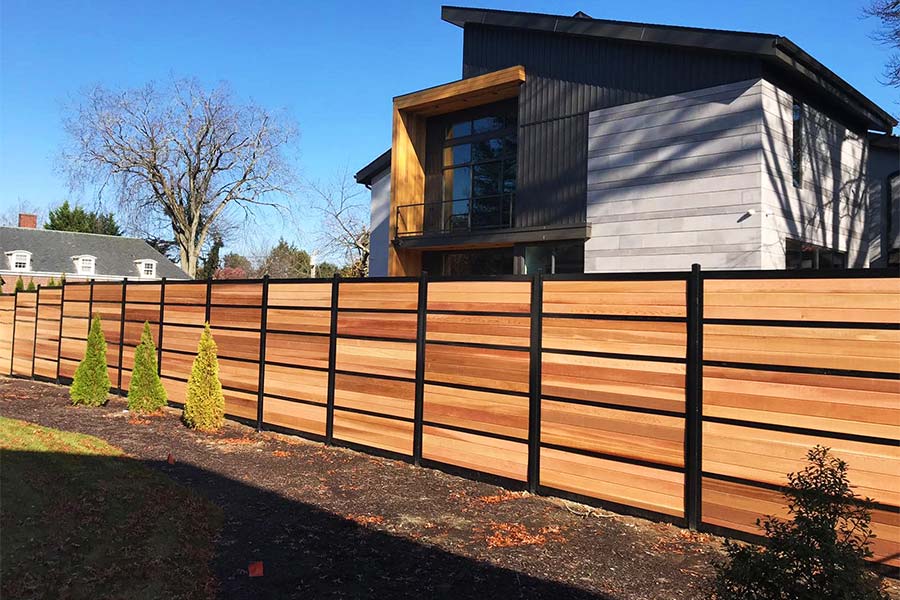All Categories
Featured

Among the most prominent options, wood, vinyl, and light weight aluminum each offer special advantages and disadvantages. Below's a malfunction of the pros and cons of these 3 common fencing materials.
Timber Secure Fencing. Wood fence has been a timeless option for house owners due to its all-natural appeal and versatility.
Pros:. Visual Charm: Timber uses a classic and warm look that matches a selection of building styles. Adjustable: It can be repainted, stained, or cut into distinct layouts to fit individual choices. Cost-Effective: Initially, wood fencing can be a budget-friendly option compared to other products. Eco-Friendly: Timber is a renewable resource and can be sustainably sourced. Disadvantages:. High Maintenance: Timber needs routine sealing, staining, or paint to avoid rot, insect damages, and weathering. Durability Issues: Without correct care, timber can warp, crack, or degeneration in time, particularly in areas with high humidity. Much shorter Life expectancy: A timber fence usually lasts 10-20 years, relying on the sort of timber and degree of maintenance. Timber is ideal for those that value a typical look and agree to commit to its maintenance.
Vinyl Fencing. Vinyl is a modern-day, low-maintenance secure fencing choice that has actually grown in popularity in recent times.

Pros:. Reduced Upkeep: Plastic does not require painting, discoloration, or sealing and can be quickly cleaned up with soap and water. Weather Resistant: It endures harsh climate condition without deteriorating, rusting, or warping. Long-Lasting: Vinyl fences can last 20-30 years with marginal maintenance. Variety of Styles: Offered in several colors, layouts, and appearances, some vinyl alternatives mimic the look of wood. Cons:. Higher Upfront Cost: Vinyl secure fencing can be extra expensive at first contrasted to wood. Brittleness in Cold Weather condition: In extreme cold, vinyl may break or become brittle. Limited Services: Specific panels can be difficult to replace, needing mindful matching to the existing fencing. Vinyl is ideal matched for homeowners looking for a resilient, low-maintenance solution with modern-day appearances.
Aluminum Fencing. Light weight aluminum fence is a durable and lightweight option, often picked for its modern look and adaptability.
Pros:. Rust-Resistant: Aluminum does not corrosion, making it an outstanding selection for damp or damp climates. Reduced Maintenance: Needs very little maintenance and is easy to clean. Durable: While lightweight, aluminum is solid enough to stand up to many ecological problems. Lengthy Lifespan: Can last several years without significant wear or degeneration. Range of Styles: Offers a stylish and streamlined look, frequently utilized for attractive or ornamental functions. Cons:. Greater Price: The initial financial investment for light weight aluminum secure fencing is higher than timber or vinyl. Much Less Personal privacy: Aluminum fences are often made with open pickets, making them less reliable for personal privacy. Vulnerable to Damages: Although long lasting, aluminum can be dented by solid impacts. Aluminum is excellent for those seeking an elegant, resilient choice that needs minimal treatment.
Making the Right Choice. Each fencing material-- light weight aluminum, wood, and vinyl-- uses distinct advantages and drawbacks. Your decision ought to depend upon your specific priorities, such as spending plan, upkeep choices, environment, and visual goals:
If you love a standard look and don't mind normal upkeep,Pick wood. Go with vinyl if you desire a low-maintenance, weather-resistant fence with modern-day allure. Choose light weight aluminum if you prioritize longevity, corrosion resistance, and a smooth design. By weighing these benefits and drawbacks, you can select a secure fencing material that improves your property while fulfilling your functional needs.
Latest Posts
Crafting a Winning Advertising Method with Full Circle Strategic Marketing
Published May 04, 25
1 min read
Why Metro Detroit Homeowners Depend On Bath Fitter for Life
Published May 03, 25
1 min read
Explore Top-Tier Auto Repair near St. Louis – Your Trusted Auto Solution
Published May 03, 25
1 min read
More
Latest Posts
Crafting a Winning Advertising Method with Full Circle Strategic Marketing
Published May 04, 25
1 min read
Why Metro Detroit Homeowners Depend On Bath Fitter for Life
Published May 03, 25
1 min read
Explore Top-Tier Auto Repair near St. Louis – Your Trusted Auto Solution
Published May 03, 25
1 min read